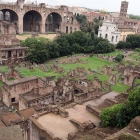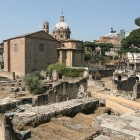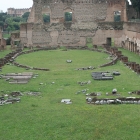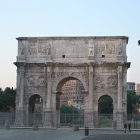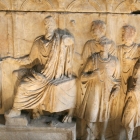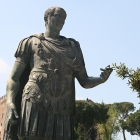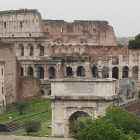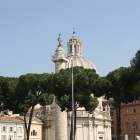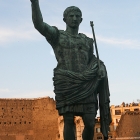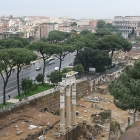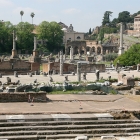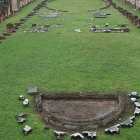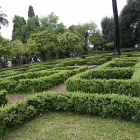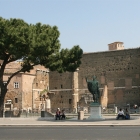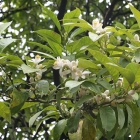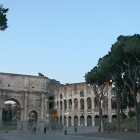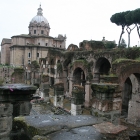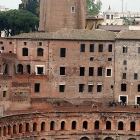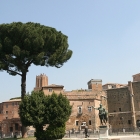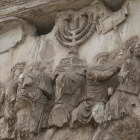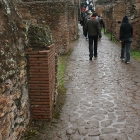Roman forum in the ancient Rome
The forum was the most important public place in ancient Rome, an open space surrounded by columns and statues of revered historic figures, in which the local elite could meet to discuss politics, raise popular support, take part in elections and make commerce. Temples and political institutions surrounded the forum.
A term somewhat misleading for today’s reader, the basilica was not a religious building. It was a very large covered building more similar to a mall of our times, in which the Romans traded and could come in front of a judge to settle their disputes. When Christianity was no longer prosecuted in Rome starting with Constantine, the architecture of the basilica was borrowed as to differentiate from that of the pagan temples and later modified to have the footprint of a cross. A wing of the Basilica of Maxentius and Constantine, with its rounded vaults can still be seen next to the forum in Rome.
In the republican age, the Senate was also next to the forum as were temples dedicated to the gods imported from Greek mythology or promoted from the best rulers of the empire. Before the republic, during monarchy, the Senate was more a council of the elders consulted by the king. Its meetings were held in a temple and later in a distinct building. The power of the senate grew during republic and declined in the imperial age. Social classes were very important in Rome. The upper class were the patricians, who were descendants of the families that founded the city. The most prominent of the patricians were patrons, which meant they had clients they protected in exchange for their vote or sometimes work. The patrons themselves might be clients of other patrons who would represent their interests at a higher level, so the patron-client relationship was not a rigid one. The vast majority of the population were plebeians and clients to someone. The plebeians were immigrants or former slaves. A plebeian could even enter the Senate after being promoted as an equestrian, being granted a horse to serve in the cavalry. The plebeians had a representative called a tribune, who had virtual impunity and the right to veto any decision of the Senate.
During republic, the army was formed of free citizens who had to serve for a few years (twenty was maximum, but it was rarely reached) and even payed for their own weapons used in a military campaign. The tyranny of the monarchic age was the worse collective memory of the Roman people. The fear that Caesar would proclaim himself king was among the main reasons that lead to the plot in which he was assassinated.
The most distinguished Roman rulers put their imprint on the forum, as was the case with Julius Caesar, Octavian Augustus or Nerva Trajan. The forum of Julius Caesar was a symbol of his power. A temple dedicated to the Caesar stood next to a temple of Venus, which he regarded as ancestor of his family. The Senate was sometimes gathered in front of the temple of Caesar, where a statue of his favorite horse stood. Some important works of art were also collected in the forum of Julius Caesar.
If Julius Caesar was the greatest ruler of Rome as regards political skills, Octavian Augustus had the greatest impact in the social life of the Roman people. The grand-nephew of Julius Caesar, adopted posthumously through his will, Octavius Augustus had a long rule in which he enacted tax reforms, expanded the empire and created a permanent army. The main edifice in the forum of Augustus was a temple dedicated to Mars, the war god, that he promised to build after a battle. Sometimes weapons and goods captured in battle were stored in the forum.
Another emperor very skilled at managing the empire, Vespasian, built a different type of forum that had a garden in the middle, in stead of a paved ground. The forum of Vespasian, known as the Temple of Peace, was built after the conquer of Jerusalem and is said to have housed the Menorah, the sacred seven arms chandelier of the Jewish people. Domitian and then Nerva took further the project of a civic center of Rome, but most of the remains we have are from the adopted son of Nerva, Trajan.
Trajan was probably the greatest emperor of Rome as regard the military achievements. The forum was completed with a basilica and the monumental Column of Trajan, which is still standing today. They were all the work of Apollodorus of Damascus, the famous architect and were financed by the impressive gold reserves found in the conquered Dacia. The forum of Trajan included markets, a basilica, an equestrian statue of the emperor and even a temple to himself.
The Roman forum was located between two of the seven columns of Rome, the Capitoline and the Palatine Hill. The latter can still be climbed today to better view the ruins and is the most important of the seven. According to Latin mythology, it all started here, where was found the cave of the she-wolf that fed Romulus and Remus, the founders of Rome. Traces of living on the Palatine Hill are as old as 3000 years.
From the Palatine Hill two arches of triumph can be seen. The first one is built by Constantine near the Colosseum and marks the victory over Maxentius in the civil war. Few hundreds of meters away, the arch of Titus, was built by his brother Domitian, in the memory of Titus’ victories. On the inside of one foot we can see the Roman soldiers carrying the booty from Jerusalem, symbolized by a Menorah. The arch of Titus was used as a model by Napoleon, when he built his own arch of triumph in Paris.
A scaled down model of the Roman Forum during Trajan can be seen in the National History Museum in Bucharest, Romania.
Mai multe despre: Architecture, Italia • Arch of Constantine • Italia • Italy • Roma • Roman Empire • Rome • Trajan- Home Page
start page - Architecture
landmark buildings - Sacred architecture
places of worship - Nature
landscape photography - Concert
performing artists - Christmas
Santa Claus pictures
- Jooble
jobs for photographers - Escape
an out of control blog - Merry Christmas
The best organizer of Christmas parties - Astro photo
Eclipse hunting and astrological photography

